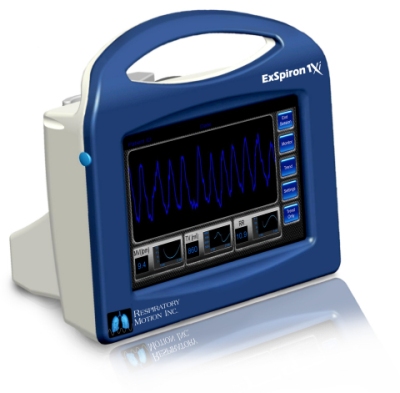Oct 12 2012
Respiratory Motion, Inc. today announced 510(k) clearance from the US Food and Drug Administration (FDA) for its ExSpiron respiratory monitoring system, the first to provide continuous, noninvasive Minute Ventilation data in non-ventilated patients. A presentation on the technology will be given at the American Society of Anesthesiologists (ASA) annual conference on October 16.
 ExSpiron respiration monitor
ExSpiron respiration monitor
Minute Ventilation data (the amount of air that enters/leaves the lungs every minute) – along with ExSpiron’s other respiratory data – are vital, quantitative measures of breathing that have not been previously available to physicians across the continuum of care.
In the hospital, changes in breathing status often precede deterioration towards respiratory depression and arrest. In-hospital cardiopulmonary arrests are estimated to be as high as 750,000 annually, leading to 50,000 deaths. Respiratory depression can occur partly in response to medications, such as narcotic painkillers and sedatives commonly administered after surgery. Given the strength of these medications and the fact that each patient’s response is unique – respiratory depression can strike even when least expected. Averting respiratory failure via early detection can reduce catastrophic events, improve patient care and outcomes, decrease healthcare costs, and save lives.
“As a cardiothoracic surgeon, I am all too aware of the grave threat that respiratory depression presents post-operatively or in other scenarios where respiration is compromised such as with opioid therapy or in certain disease states,” states Jenny E. Freeman, MD and CEO of Respiratory Motion, Inc. “Respiratory Motion’s ExSpiron provides the same volume metrics that physicians have come to rely on to manage patients on mechanical ventilators. We are now making these measurements continuously available for non-ventilated patients via a small, noninvasive bedside monitor. Respiratory Motion, Inc. has been created to develop technologies to assist clinicians in their fight against respiratory depression and help improve patient safety. We have seen significant physician interest in our technology and are pleased to be providing a new, quantitative tool to help address this critically important challenge that is faced every day in caring for patients following surgery.”
Both the Anesthesia Patient Safety Foundation (apsf) and the American Society of Anesthesiologists (ASA) encourage improved ventilation assessment to help combat adverse respiratory events; with the ASA officially adding to its practice standards the continual observation of ventilation in any patient following anesthesia.
Traditional clinical observations and bedside monitoring of respiratory status can be late indicators of decompensation in non-ventilated patients, such as those in the post-op recovery room. Underlying physiology, published studies and tragic case reports support the need for better monitoring.
ExSpiron’s industry-unique combination of respiratory metrics was designed to provide continuous, accurate quantitative readings of Minute Ventilation (the amount of air that enters/leaves the lungs every minute) never before continuously captured in non-ventilated patients; respiration rate (breaths per minute); and tidal volume (the volume of air in a single breath). The system is also clinically practical and patient-friendly. Monitoring can be performed by nurses, physicians or other healthcare clinicians by simply applying a chest sensor to the patient, after which data is generated continuously and automatically.
The addition of Minute Ventilation data and its trending over time provides new objective metrics to assist clinicians in the immediate evaluation of the pulmonary system and demonstrates changes in respiratory status.
“This device stands to provide a quantitative metric of respiratory function much in the same manner that cardiac monitoring did for cardiac and intensive care patients,” explains Gary John Mullen, MD, an anesthesiologist at Vidant Healthcare in North Carolina and a clinical advisor to the company. “The ExSpiron will help nurses and care teams keep a constant watch on the high volume of patients under their care and feed them real-time, quantitative data as an important adjunct to patient assessment and decision making.”
Given the known challenge in the medical community for improved respiratory monitoring and the new quantitative solution that ExSpiron is delivering, Respiratory Motion has an increasing presence at clinical conferences. Upcoming clinical presentations of the ExSpiron technology will take place at the annual conferences of the American Society of Anesthesiologists, American College of Chest Physicians, American Heart Association and Society of Critical Care Medicine, all within the next three months, with additional presentations later in 2013. These follow a series of other notable presentations in the past year at conferences of the American Thoracic Society, Society of Critical Care Medicine, American Heart Association, American Pain Society, American Academy of Pain Medicine and Smart Monitoring.
The ExSpiron will be available for clinicians beginning in January 2013 in the initial hospital settings of anesthesia/OR, post-op recovery and intensive care units.